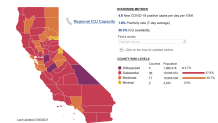Los Angeles and Orange counties were ready Tuesday for another round of reopenings when state officials released figures that indicated they are eligible to move into the orange tier of pandemic restrictions.
The official move for Orange County came later Tuesday, with officials announcing it would be able to loosen restrictions according to the orange tier the following day, Wednesday.
During a news conference with Dr. Barbara Ferrer, she said LA County would be able to loosen restrictions April 5.
Qualifying for the orange tier -- the third-least restrictive of California’s four-tier system -- requires a county to have an average daily rate of new COVID infections of 3.9 per 100,000 residents, along with a testing-positivity rate of 4.9% or less, and maintain those levels for two consecutive weeks.
Get top local stories in Southern California delivered to you every morning. Sign up for NBC LA's News Headlines newsletter.
SoCal Reopenings: Get Info on Museums, Aquariums, Theme Parks, Theaters
Los Angeles County fell into the orange-tier range last week, with a case rate of 3.7 per 100,000 residents, and a testing-positivity rate of 1.8%. The county met the criteria again when the state released updated numbers Tuesday, allowing it to officially qualify to move out of the red tier and into the orange tier.
In Orange County, the case rate per 100,000 people dropped from 2.9 on Sunday to 2.8 Monday. The positivity rate was at 1.7% on Monday and at 2.6% for the health equity index, which measures infection rates in underprivileged communities hardest hit by the pandemic.

State rules require counties to remain in a tier for three weeks before it can advance in the Blueprint for a Safer Economy.
Local
Get Los Angeles's latest local news on crime, entertainment, weather, schools, COVID, cost of living and more. Here's your go-to source for today's LA news.
Los Angeles County officially entered the red tier on March 12, so it technically cannot advance to orange until Friday.
It's a move that LA County Public Health Director Barbara Ferrer was certainly expecting -- just not this soon.
Ferrer even went as far as to say that LA County had all but met the metrics for the yellow tier during the Tuesday news conference.
Previously, LA County delayed a move to red-tier guidelines for three days to give business owners time to make required adjustments.
Meanwhile, California is expanding vaccine eligibility to people 50 and older starting Thursday and to all adults on April 15. Statewide, more than 6 million people in the state of nearly 40 million are fully inoculated and more than 17 million doses have been administered.
Moving to the orange tier would authorize the county to lift all capacity restrictions at retail and personal care businesses, while raising the capacity limit from 25% to 50% for movie theaters, churches, museums, zoos, aquariums and restaurants. Fitness center capacity could be increased from 10% to 25%. The orange tier also would allow for bars to reopen outdoors, while card rooms and family entertainment centers could be cleared to resume indoor operations.
Orange County CEO Frank Kim said the move could happen Wednesday.
"They will allow us to move into the orange tier Wednesday as long as they give us the green light (Tuesday),'' Kim said earlier this week.
Orange County has qualified for the yellow tier in positivity rates for the last six days, but it will take a while for the county to move up to that least-restrictive tier because the case rate must fall below one, Kim said.
Refresh this page for updates.
California COVID-19 Vaccinations
The map tracks the number of doses administered by a recipient's county of residence according to the The California Department of Public Health.
Source: The statewide totals for doses administered reflect Centers for Disease Control and Prevention data. Otherwise we used data from the California Department of Public Health.
Amy O’Kruk/NBC



